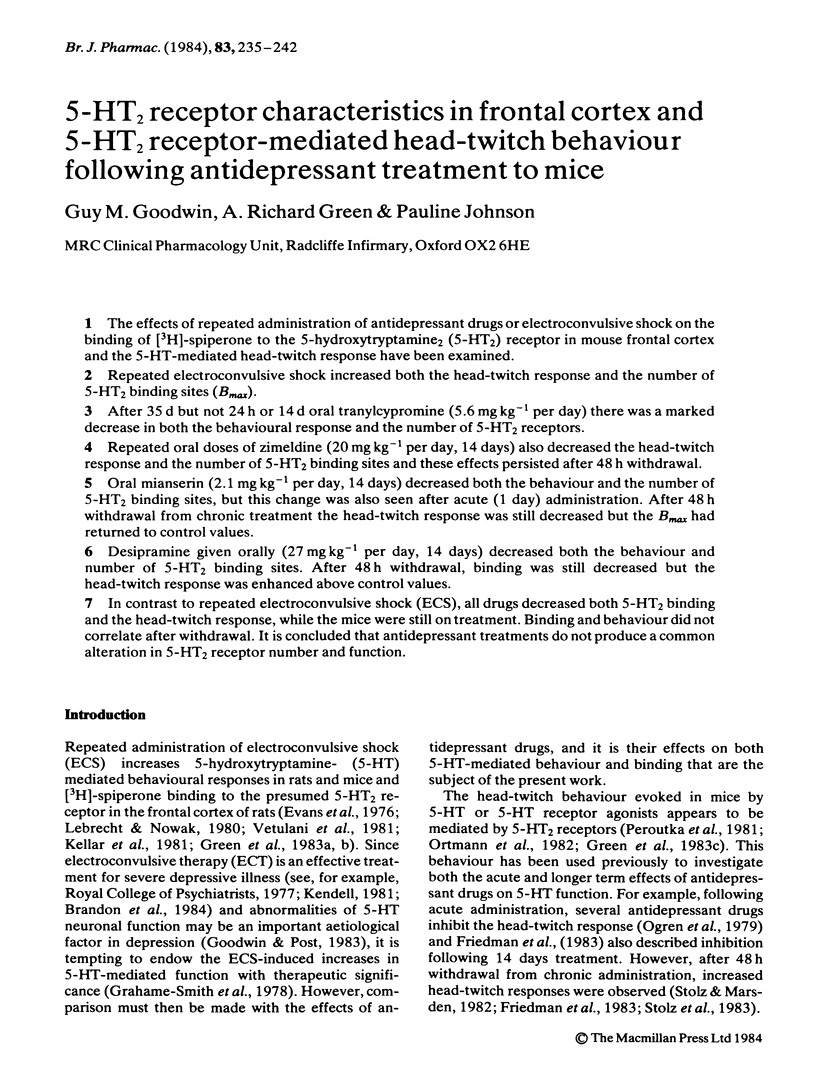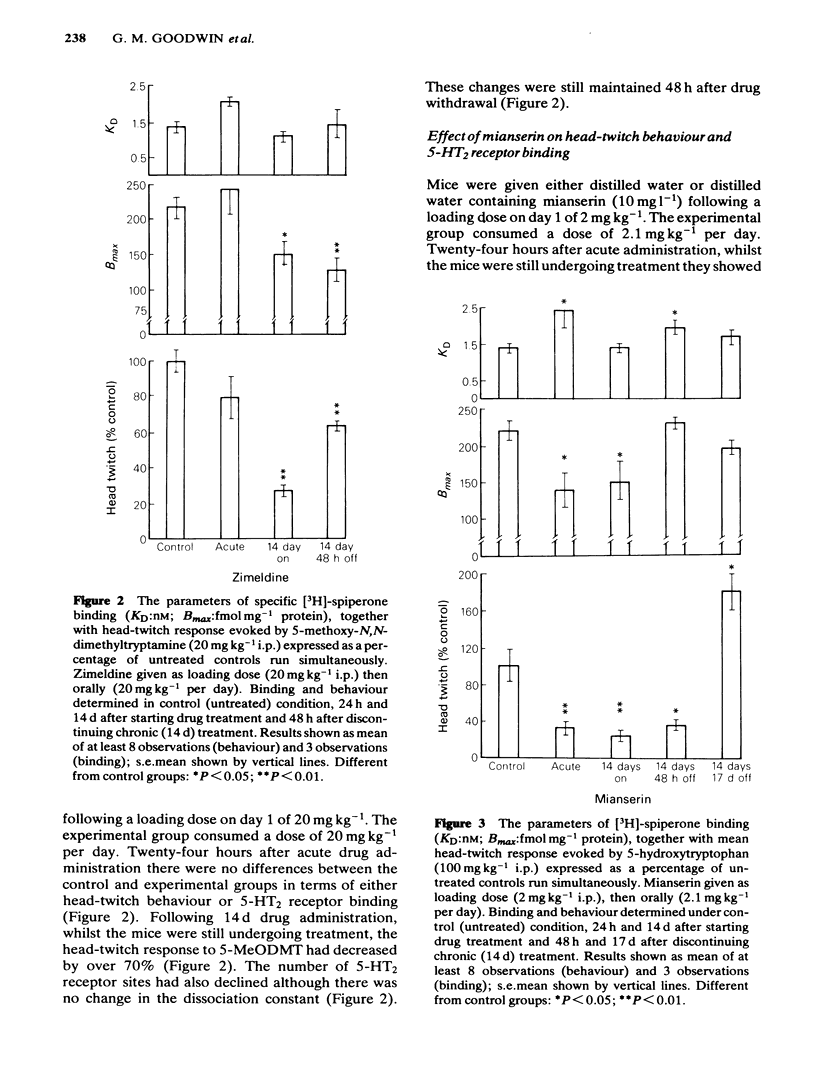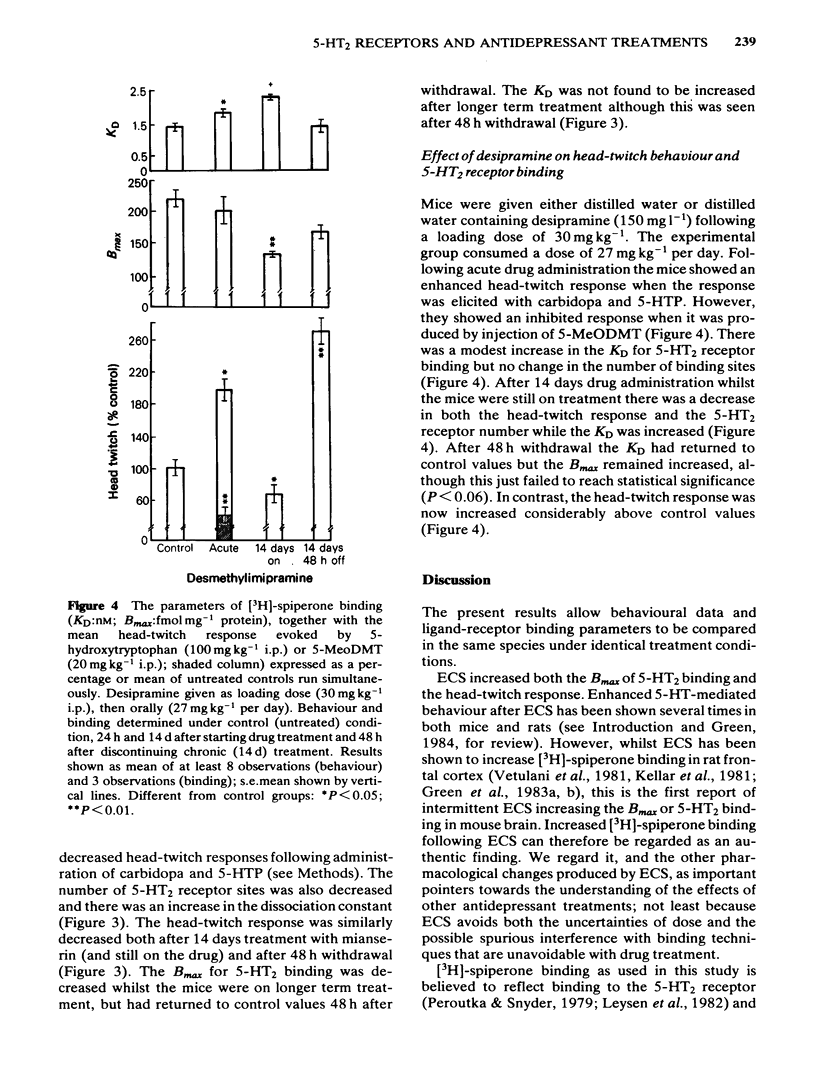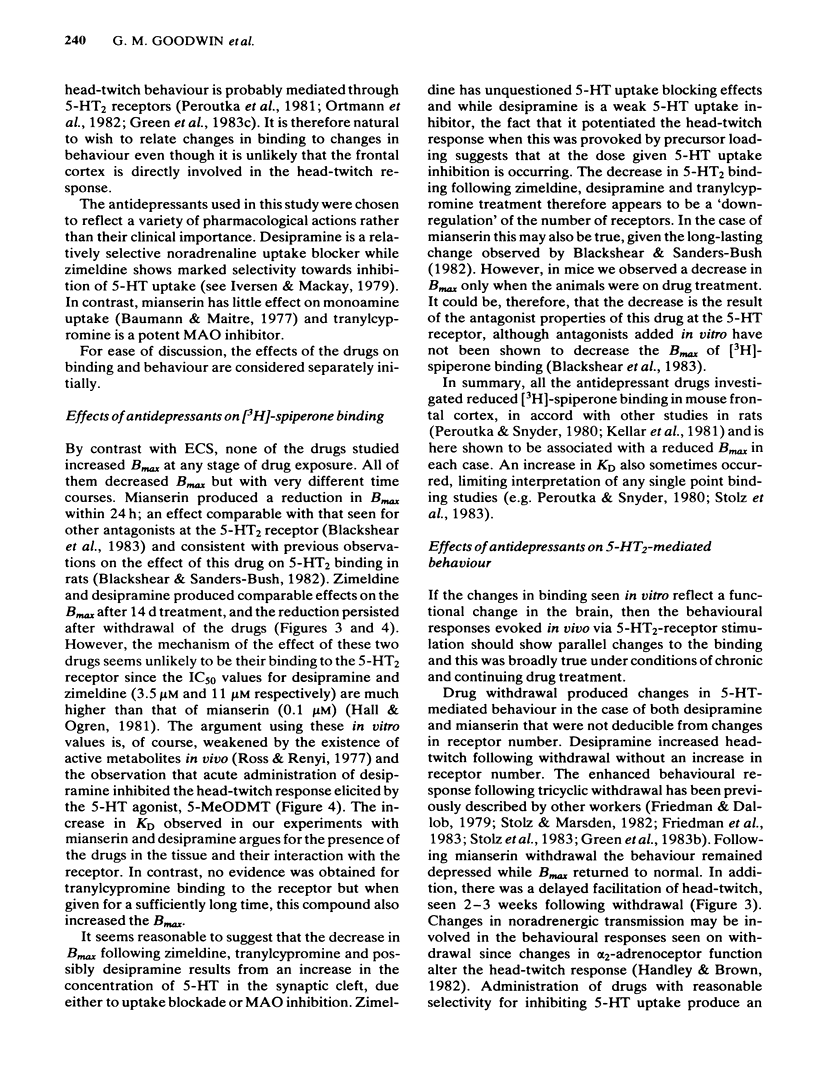Abstract
The effects of repeated administration of antidepressant drugs or electroconvulsive shock on the binding of [3H]-spiperone to the 5-hydroxytryptamine 2 (5-HT2) receptor in mouse frontal cortex and the 5-HT-mediated head-twitch response have been examined. Repeated electroconvulsive shock increased both the head-twitch response and the number of 5-HT2 binding sites (Bmax). After 35 d but not 24 h or 14 d oral tranylcypromine (5.6 mg kg-1 per day) there was a marked decrease in both the behavioural response and the number of 5-HT2 receptors. Repeated oral doses of zimeldine (20 mg kg-1 per day, 14 days) also decreased the head-twitch response and the number of 5-HT2 binding sites and these effects persisted after 48 h withdrawal. Oral mianserin (2.1 mg kg-1 per day, 14 days) decreased both the behaviour and the number of 5-HT2 binding sites, but this change was also seen after acute (1 day) administration. After 48 h withdrawal from chronic treatment the head-twitch response was still decreased but the Bmax had returned to control values. Desipramine given orally (27 mg kg-1 per day, 14 days) decreased both the behaviour and number of 5-HT2 binding sites. After 48 h withdrawal, binding was still decreased but the head-twitch response was enhanced above control values. In contrast to repeated electroconvulsive shock (ECS), all drugs decreased both 5-HT2 binding and the head-twitch response, while the mice were still on treatment.(ABSTRACT TRUNCATED AT 250 WORDS)
Full text
PDF







Selected References
These references are in PubMed. This may not be the complete list of references from this article.
- Bacopoulos N. G. Antipsychotic drug effects on dopamine and serotonin receptors: in vitro binding and in vivo turnover studies. J Pharmacol Exp Ther. 1981 Dec;219(3):708–714. [PubMed] [Google Scholar]
- Baumann P. A., Maître L. Blockade of presynaptic alpha-receptors and of amine uptake in the rat brain by the antidepressant mianserine. Naunyn Schmiedebergs Arch Pharmacol. 1977 Oct;300(1):31–37. doi: 10.1007/BF00505077. [DOI] [PubMed] [Google Scholar]
- Bergstrom D. A., Kellar K. J. Effect of electroconvulsive shock on monoaminergic receptor binding sites in rat brain. Nature. 1979 Mar 29;278(5703):464–466. doi: 10.1038/278464a0. [DOI] [PubMed] [Google Scholar]
- Blackshear M. A., Friedman R. L., Sanders-Bush E. Acute and chronic effects of serotonin (5HT) antagonists on serotonin binding sites. Naunyn Schmiedebergs Arch Pharmacol. 1983 Sep;324(2):125–129. doi: 10.1007/BF00497017. [DOI] [PubMed] [Google Scholar]
- Blackshear M. A., Sanders-Bush E. Serotonin receptor sensitivity after acute and chronic treatment with mianserin. J Pharmacol Exp Ther. 1982 May;221(2):303–308. [PubMed] [Google Scholar]
- Brandon S., Cowley P., McDonald C., Neville P., Palmer R., Wellstood-Eason S. Electroconvulsive therapy: results in depressive illness from the Leicestershire trial. Br Med J (Clin Res Ed) 1984 Jan 7;288(6410):22–25. doi: 10.1136/bmj.288.6410.22. [DOI] [PMC free article] [PubMed] [Google Scholar]
- Brunello N., Barbaccia M. L., Chuang D. M., Costa E. Down-regulation of beta-adrenergic receptors following repeated injections of desmethylimipramine: permissive role of serotonergic axons. Neuropharmacology. 1982 Nov;21(11):1145–1149. doi: 10.1016/0028-3908(82)90172-1. [DOI] [PubMed] [Google Scholar]
- Evans J. P., Grahame-Smith D. G., Green A. R., Tordoff A. F. Electroconvulsive shock increases the behavioural responses of rats to brain 5-hydroxytryptamine accumulation and central nervous system stimulant drugs. Br J Pharmacol. 1976 Feb;56(2):193–199. doi: 10.1111/j.1476-5381.1976.tb07442.x. [DOI] [PMC free article] [PubMed] [Google Scholar]
- Friedman E., Cooper T. B., Dallob A. Effects of chronic antidepressant treatment on serotonin receptor activity in mice. Eur J Pharmacol. 1983 Apr 22;89(1-2):69–76. doi: 10.1016/0014-2999(83)90609-x. [DOI] [PubMed] [Google Scholar]
- Friedman E., Dallob A. Enhanced serotonin receptor activity after chronic treatment with imipramine or amitriptyline. Commun Psychopharmacol. 1979;3(2):89–92. [PubMed] [Google Scholar]
- Goodwin F. K., Post R. M. 5-hydroxytryptamine and depression: a model for the interaction of normal variance with pathology. Br J Clin Pharmacol. 1983;15 (Suppl 3):393S–405S. doi: 10.1111/j.1365-2125.1983.tb02130.x. [DOI] [PMC free article] [PubMed] [Google Scholar]
- Grahame-Smith D. G., Green A. R., Costain D. W. Mechanism of the antidepressant action of electroconvulsive therapy. Lancet. 1978 Feb 4;1(8058):254–257. doi: 10.1016/s0140-6736(78)90495-6. [DOI] [PubMed] [Google Scholar]
- Green A. R., Heal D. J., Johnson P., Laurence B. E., Nimgaonkar V. L. Antidepressant treatments: effects in rodents on dose-response curves of 5-hydroxytryptamine- and dopamine-mediated behaviours and 5-HT2 receptor number in frontal cortex. Br J Pharmacol. 1983 Oct;80(2):377–385. doi: 10.1111/j.1476-5381.1983.tb10044.x. [DOI] [PMC free article] [PubMed] [Google Scholar]
- Green A. R., Johnson P., Nimgaonkar V. L. Increased 5-HT2 receptor number in brain as a probable explanation for the enhanced 5-hydroxytryptamine-mediated behaviour following repeated electroconvulsive shock administration to rats. Br J Pharmacol. 1983 Sep;80(1):173–177. doi: 10.1111/j.1476-5381.1983.tb11063.x. [DOI] [PMC free article] [PubMed] [Google Scholar]
- Green A. R., O'Shaughnessy K., Hammond M., Schächter M., Grahame-Smith D. G. Inhibition of 5-hydroxytryptamine-mediated behaviour by the putative 5-HT2 antagonist pirenperone. Neuropharmacology. 1983 May;22(5):573–578. doi: 10.1016/0028-3908(83)90147-8. [DOI] [PubMed] [Google Scholar]
- Hall H., Ogren S. O. Effects of antidepressant drugs on different receptors in the brain. Eur J Pharmacol. 1981 Mar 26;70(3):393–407. doi: 10.1016/0014-2999(81)90172-2. [DOI] [PubMed] [Google Scholar]
- Handley S. L., Brown J. Effects on the 5-hydroxytryptamine-induced head-twitch of drugs with selective actions on alpha1 and alpha2-adrenoceptors. Neuropharmacology. 1982 Jun;21(6):507–510. doi: 10.1016/0028-3908(82)90040-5. [DOI] [PubMed] [Google Scholar]
- Heal D. J., Akagi H., Bowdler J. M., Green A. R. Repeated electroconvulsive shock attenuates clonidine-induced hypoactivity in rodents. Eur J Pharmacol. 1981 Nov 5;75(4):231–237. doi: 10.1016/0014-2999(81)90549-5. [DOI] [PubMed] [Google Scholar]
- Heal D. J., Lister S., Smith S. L., Davies C. L., Molyneux S. G., Green A. R. The effects of acute and repeated administration of various antidepressant drugs on clonidine-induced hypoactivity in mice and rats. Neuropharmacology. 1983 Aug;22(8):983–992. doi: 10.1016/0028-3908(83)90214-9. [DOI] [PubMed] [Google Scholar]
- Janowsky A., Okada F., Manier D. H., Applegate C. D., Sulser F., Steranka L. R. Role of serotonergic input in the regulation of the beta-adrenergic receptor-coupled adenylate cyclase system. Science. 1982 Nov 26;218(4575):900–901. doi: 10.1126/science.6291152. [DOI] [PubMed] [Google Scholar]
- Kellar K. J., Cascio C. S., Butler J. A., Kurtzke R. N. Differential effects of electroconvulsive shock and antidepressant drugs on serotonin-2 receptors in rat brain. Eur J Pharmacol. 1981 Feb 19;69(4):515–518. doi: 10.1016/0014-2999(81)90460-x. [DOI] [PubMed] [Google Scholar]
- Kendell R. E. The present status of electroconvulsive therapy. Br J Psychiatry. 1981 Oct;139:265–283. doi: 10.1192/bjp.139.4.265. [DOI] [PubMed] [Google Scholar]
- Lebrecht U., Nowak J. Z. Effect of single and repeated electroconvulsive shock on serotonergic system in rat brain--II. Behavioural studies. Neuropharmacology. 1980 Nov;19(11):1055–1061. doi: 10.1016/0028-3908(80)90101-x. [DOI] [PubMed] [Google Scholar]
- Leysen J. E., Niemegeers C. J., Van Nueten J. M., Laduron P. M. [3H]Ketanserin (R 41 468), a selective 3H-ligand for serotonin2 receptor binding sites. Binding properties, brain distribution, and functional role. Mol Pharmacol. 1982 Mar;21(2):301–314. [PubMed] [Google Scholar]
- Ogren S. O., Fuxe K., Agnati L. F., Gustafsson J. A., Jonsson G., Holm A. C. Reevaluation of the indoleamine hypothesis of depression. Evidence for a reduction of functional activity of central 5-HT systems by antidepressant drugs. J Neural Transm. 1979;46(2):85–103. doi: 10.1007/BF01250331. [DOI] [PubMed] [Google Scholar]
- Ortmann R., Bischoff S., Radeke E., Buech O., Delini-Stula A. Correlations between different measures of antiserotonin activity of drugs. Study with neuroleptics and serotonin receptor blockers. Naunyn Schmiedebergs Arch Pharmacol. 1982 Dec;321(4):265–270. doi: 10.1007/BF00498511. [DOI] [PubMed] [Google Scholar]
- Peroutka S. J., Lebovitz R. M., Snyder S. H. Two distinct central serotonin receptors with different physiological functions. Science. 1981 May 15;212(4496):827–829. doi: 10.1126/science.7221567. [DOI] [PubMed] [Google Scholar]
- Peroutka S. J., Snyder S. H. Long-term antidepressant treatment decreases spiroperidol-labeled serotonin receptor binding. Science. 1980 Oct 3;210(4465):88–90. doi: 10.1126/science.6251550. [DOI] [PubMed] [Google Scholar]
- Rosenfeld M. R., Makman M. H. The interaction of lisuride, an ergot derivative, with serotonergic and dopaminergic receptors in rabbit brain. J Pharmacol Exp Ther. 1981 Mar;216(3):526–531. [PubMed] [Google Scholar]
- Ross S. B., Renyi A. L. Inhibition of the neuronal uptake of 5-hydroxytryptamine and noradrenaline in rat brain by (Z)- and (E)-3-(4-bromophenyl)-N,N-dimethyl-3-(3-pyridyl) allylamines and their secondary analogues. Neuropharmacology. 1977 Jan;16(1):57–63. doi: 10.1016/0028-3908(77)90048-x. [DOI] [PubMed] [Google Scholar]
- Sellinger-Barnette M. M., Mendels J., Frazer A. The effect of psychoactive drugs on beta-adrenergic receptor binding sites in rat brain. Neuropharmacology. 1980 May;19(5):447–454. doi: 10.1016/0028-3908(80)90052-0. [DOI] [PubMed] [Google Scholar]
- Southgate J., Collins G. G. The estimation of monoamine oxidase using 14C-labelled substrates. Biochem Pharmacol. 1969 Sep;18(9):2285–2287. doi: 10.1016/0006-2952(69)90341-4. [DOI] [PubMed] [Google Scholar]
- Stolz J. F., Marsden C. A., Middlemiss D. N. Effect of chronic antidepressant treatment and subsequent withdrawal on [3H]-5-hydroxytryptamine and [3H]-spiperone binding in rat frontal cortex and serotonin receptor mediated behaviour. Psychopharmacology (Berl) 1983;80(2):150–155. doi: 10.1007/BF00427959. [DOI] [PubMed] [Google Scholar]
- Stolz J. F., Marsden C. A. Withdrawal from chronic treatment with metergoline, dl-propranolol and amitriptyline enhances serotonin receptor mediated behaviour in the rat. Eur J Pharmacol. 1982 Apr 8;79(1-2):17–22. doi: 10.1016/0014-2999(82)90570-2. [DOI] [PubMed] [Google Scholar]
- Vetulani J., Lebrecht U., Pilc A. Enhancement of responsiveness of the central serotonergic system and serotonin-2 receptor density in rat frontal cortex by electroconvulsive treatment. Eur J Pharmacol. 1981 Nov 19;76(1):81–85. doi: 10.1016/0014-2999(81)90012-1. [DOI] [PubMed] [Google Scholar]


